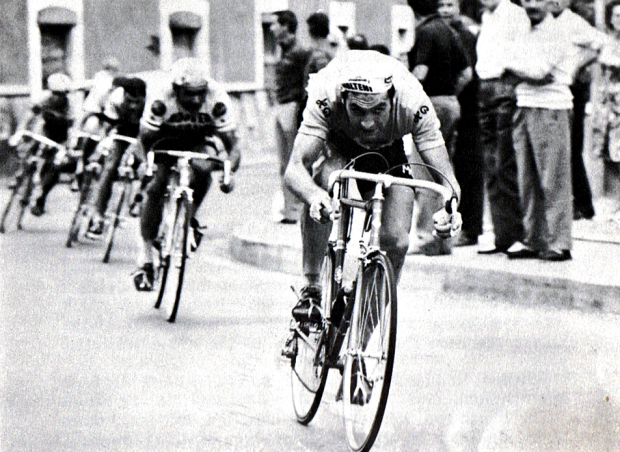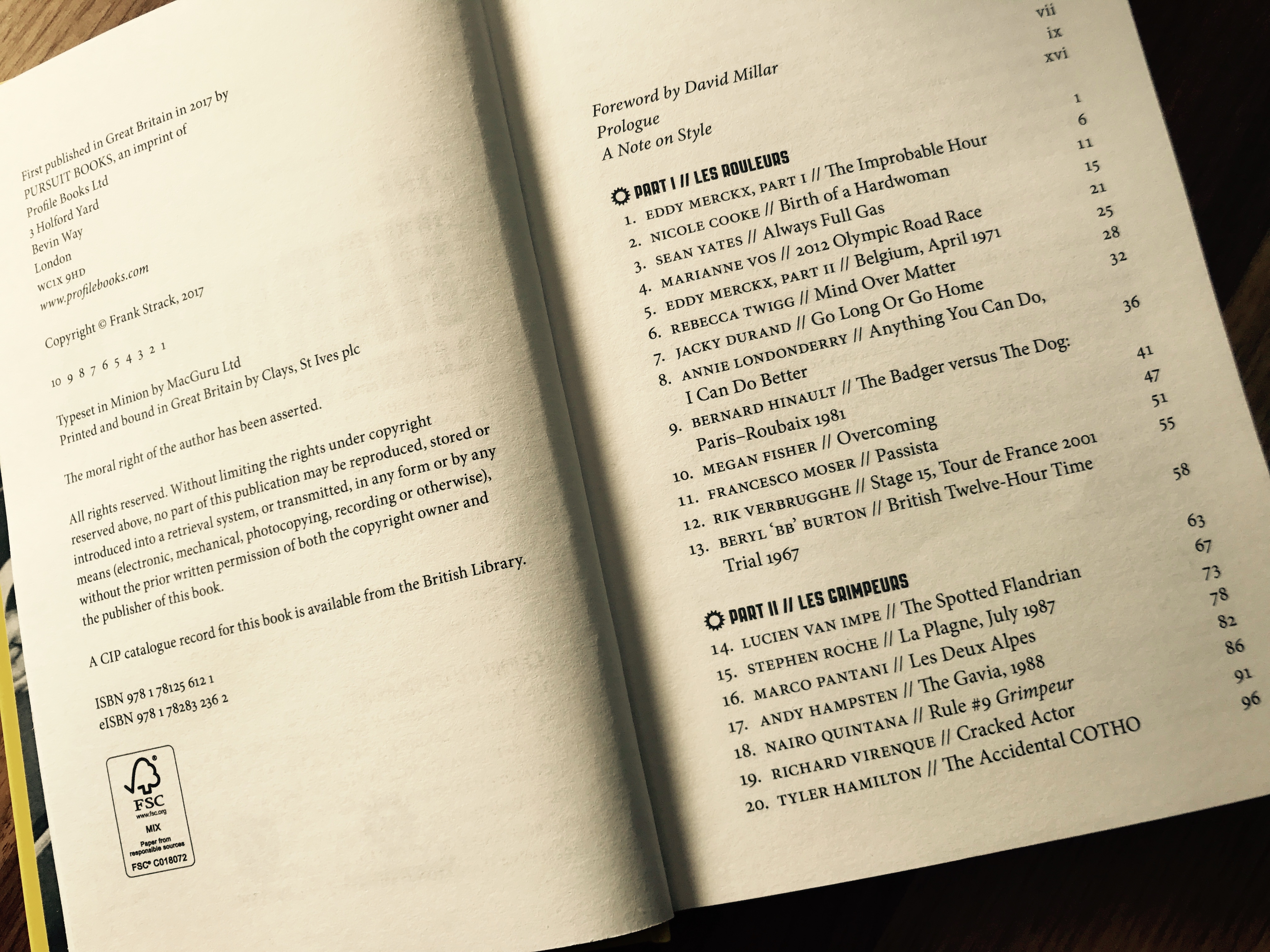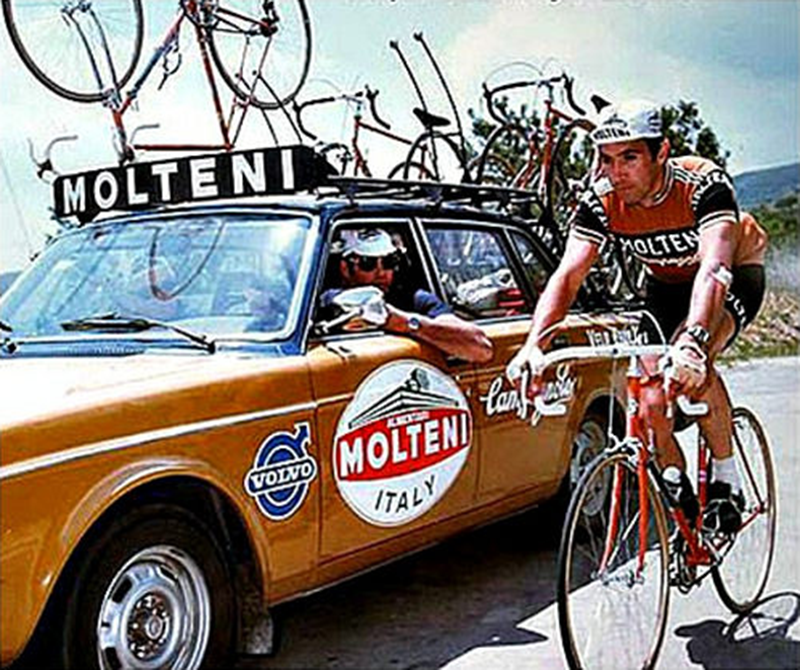Ride Like a Leader: White Bar Tape

When done correctly, Cycling can be both the hardest and dirtiest of sports. We relish in the glory of returning from a ride, battered by the four winds and soaked by the seven rains; our bodies, faces, and machines covered in the reasons why most people might stay indoors. Given that, there is something almost cavalier about submitting to the deluge in the color white, particularly when it comes to shoes, socks, jerseys, and bar tape.
Modern cycling teams, with budgets outsized only by the egos inhabiting the roster, are tending strongly towards a Three Musketeers, unus pro omnibus, omnes pro uno mentality. Yet, in years gone by, when Rule #5 was a way of life more so than a badge of honor as it is for us, teams were dominated by a single leader who shouldered responsibility in all manner of races throughout the season. In those days, team bikes were generally built, as they are now, in accordance with Rule #8, with bars wrapped in blue, black, red, or green tape. One bike, however, always stood out as the exception: the team leader’s bars were always wrapped in white.
White is a glorious color to grace a set of handlebars. It emphasizes the sensual sweep of the drops and the beautiful curve from the hoods to the tops. It brings out the crisp shadows of the cables running beneath the tape to highlight a perfect wrap. It stands as a testament to the care that is undertaken in maintaining the machine, for without meticulous attention white does not stay white for long. It states that these bars are graced not by the sullied hands of a domestique, but by the clean grip of a leader.
When it comes to wrapping bars, there are many classy possibilities – black is always stylish and versatile (you can dress it up or you can dress it down), red is fast, celeste is classic – but for Bike #1, I always choose white not because it’s Pro, but because when I go out, I ride like a leader.


@Oli
sorry, will desist.
slightly off topic, radially spoked wheels and cobbles? Bad Idea?
It certainly wouldn’t be my preference, but if it’s built well and you’re not riding like a maniac it should be okay…I guess?
While we’re on white bar tape – I just got my bars retaped (put it on myself? hells no) in Zipp Service Course CX tape, in pristine white. The CX tape is nicely padded, and feels great. I don’t have amazingly large hands, but I do appreciate a larger diameter bar in my hands. When MTBing I prefer Oury grips. Those things are bad-arse.
The bike did have fizik tape on it, which was nice enough, but didn’t blow my mind. It was pretty quickly stained from Singapore-sweaty rides, too. Probably my fault for not cleaning tape as well as I could, and for being a sweaty bastard.
@Oli
Alternatively, a re-build might be in order. Thanks.
I might not be riding like a maniac but I will be riding with maniacs. I’m also mindful of the reduced ability to avoid stuff when riding in a group.
@Chris
Why take that chance? Probably the only time you’ll hear me say 3-cross.
@Calmante
I have no intention of taking any chances but is three-cross not overkill? Time to find a local master craftsman.
Tell me you’re not looking for an excuse not to buy more gear?!?!
Nate – very, very close to picking up those Ritchey Clasic bars & stem, then saw the bars in person on a friend’s bike. I didn’t like the drop curve on them, pretty shallow, kind of weird, in my opinion. I like classic round, they seem shallow and short.
They definitely look nice though! I’ve seen the bars, stem, post on a bike matched up. Very slick, but the bar curve seems weird to me.
@Marko
aren’t we all?
@SimonH
Funny that you wrote it in terms of your back; I was perusing Slamthatstem.com when I commented before, and my original thought was, as they say on that site, “do some yoga and slam that shit!”
Slam the stem is so inelegant. As many commentators have suggested in the past year or so, the pro’s obsession with a very low front end is probably a contributing factor is the number of big crashes that have happened in the pelotons. The lower the bars, the straighter the arms are, or the arms are locked, and so there is much less control than if the arms are bent.
Besides, salmming your stem can make you look shit
@Jarvis
I don’t know anything about accidents being more likely to occur with a lower body position. Is there any actual evidence, or is it all just anecdotal commentary? Haven’t there always been crashes in bike races?
Regardless, I don’t agree as to the aesthetics; a lower front end looks the business. I know this guy agrees.
It’s also more comfortable for me (with longer arms and torso), although I recognize that’s not the case for everyone. In the interest of full disclosure, however, I do use a thin (2 mm, I think?) spacer.
It’s not how low the position is, but how straight the arms are. Straight/locked arms have no or little control compared to bent arms – consider the Downhill MTBer, you don’t see them riding with straight/locked arms. The same goes for surfers/skaters, the legs are bent to allow control. It’s one of many varable being suggested for the seemingly higher incidences of large pile-ups in races and I consider it quite plausible.
“That guy” doesn’t know anything about position, eh @frank ?
@Jarvis
I’d agree with most of what you’re saying but the comparison with the DH mountain biker is only partially correct – bent arms are important for control but are also equally important for the role they play as part of the suspension. They’re legs are bent as well and through the properly rough bits the bike might be all over the place but the a good rider will isolate all of that and appear to glide. You don’t need to do that on a road bike.
It seems that a lot of the pro’s are on significantly smaller bikes than mere mortals like us would ride and that allows them to get the stem lower but I’ve no idea whether they’re riding smaller frames to get lower stems or they’re looking for some other benefit.
Ehh, slammed stems are nice & all, but I’m going to ride whatever allows me to ride lots and lots of kms. I don’t like yoga, can’t sit still for that long. My flexibility is bad from years and years of other sports without proper warm-up/cool down. I also really messed up my neck playing college sports. I’m working on my flexibility, but until then, I’m going with function over form.
That’s one thing I love about these parts – we’ll chatter all day over form but for most of us, when it comes down to it, we are going to do what allows us to ride all the time. Hi viz vests are lame & I wouldn’t show up at a Cogal with one, but hey, if I’m riding in the country in total darkness, I’m pulling one on.
@Jarvis
Nice to have you back.
@Jarvis
I agree completely regarding bent arms being better than straight – more shock absorption, more control – but as you say the height of the bars has little do with it; a good position should always allow for some bend in the arms and being low doesn’t by any means suggest you need straight arms. Our beloved Graeme Obree demonstrates an extreme of high bars still giving straight arms!
Obviously Obree is after something else, and I’m just showing an outrageous example that high bars can still yield straight arms.
I see lots of riders with straight arms regardless of their bar height, usually not due to too much stretch but because of laziness. Riding like that is more an indicator fo how casually they’re riding and how alert they are. I think this is much more likely the cause of crashes than is bar height.
As a side note, I recently read a study that there really aren’t any more crashes in recent years than previously; we’re just getting more injuries per crash which might have more to do with lack of bone density due to riders being unrealistically thin.
@frank
Let’s face it, 99% of us would crash spectacularly if we tried to ride in that position. The slightest wibble with the hands and wrists would see us careen wildly and dump us on our asses.
Stiffer wheels, straighter arms, skinnier riders, desperation… all add to the mix. I think the originator, or at least a supporter of the low bar position theory is De Vlaeminck*
*I’m probably wrong on this
@wiscot
And none of us would ever ride in a group like that, as we would most likely take out the entire group!
@Mikel Pearce
Hopefully the group wouldn’t allow you to ride with them like that in the first place.
As an example to the point I am making, I refer you to the picture accompanying this article. Look how bent the arms are…far better for control.
@Jarvis






Bull.
@Jarvis
Correct, you are wrong on this!
@frank
Is my back flat?
@Jarvis
@DerHoggz
No group I have ever ridden in would allow someone in an Obree egg position, simply for safety reasons.
Lots of pros can ride with arms bent despite huge saddle to bar drop (they are PROS after all), but lots of them can’t, or don’t. Look at the footage from Qatar for some great examples of both. Boonen in particular seems to be quite flexible.
@all
Obree was a track racer and no one in their right mind would ride like that now, let alone in a pack. His photo was included as a joke.
Lets move on. There are pictures of Roger de Vlaeminck in this thread now, for fuck’s sake!
Fella’s, De Vlaeminck is the gold standard when it comes to the flat back position and drilling it. No others IMHO match his aggressive stance. Many, including Spartacus come close, but lest we forget, the bikes and geometries have changed also. That may account for some subtlty here.
and…I AM SO STOKED, just bought a Ridley Damocles! will post pics later, and yes, it will have white Fizik microtex wrap
@DerHoggz
Gotta love Faboo’s 140mm stem ……
As Frank stated in a previous discussion, as you drop your bars, you will probably also need to lengthen your stem. I went through this recently going from a 105mm stem where I felt really cramped and my knees/elbows nearly in constant contact. Dropped the stem a spacer and went 135mm. Much mo’ betta now. BUT I wouldn’t have dared do that 1+ yrs ago. Amazing what more riding will do for you.
@Ron
So much for that idea. Can’t deal with those compact bend bars.
I recently went through a proper bike fit and did some research on positioning. According to Andy Pruitt, aka fitting guru, it turns out that Faboo’s position was actually not as efficient as a slightly more upright one from a wattage standpoint.
Jens has the flat back thing down pretty well.
I’m trying to find the article, but the gist of it was that Pruitt raised his TT position and then Faboo lowered it on his own shortly thereafter. He then had a poor TT relative to a test they had done in the more upright profile. Faboo then agreed to raise his position again based on the data Pruitt showed him.
Jarvis is on to it. The stem height should be a by product of a correct position, not the position should be set from the stem height.
@Chris
Bent arms are suspension even on a road bike. Also try bumping shoulders with someone with straight arms, it’s a lot easier to lose control than it is with relaxed, bent arms.
Plus slammed stems just look ugly on most bikes…
Yes, yes yes! Absolutely yes, to @Oli and @Jarvis. These men speak the Truth.
@BrianG
Related, but I presume not the article you are referring to:
Jens has a nice stack of spacers under his stem, too…
@brett
Yeah he does, and check out his risers on the TT machine!
While Faboo pops up in sprints and loses by a hair, other riders comment that he was trying to sprint on the hoods. Meanwhile teh intarwebz makes a legend out of him for having a slammed 140mm -17 degree stem. May as well cut the drops off altogether for the use he gets out of them.
@minion
Gerard Vroomen said exactly that in a blog entry with regard to Faboo sprinting on the hoods.
Slam just to “look cool”, or get a good fit from someone who knows what they are doing and let the stem be where it should be, slammed or not. You will ride more efficiently and comfortably. Seems an obvious choice to me.
Never, ever slam at the cost of having a good position. And while slammed is in-vogue, the idea is just that lower bars looks cooler. I slam my stem because I have to, and it happens to look badass.
The slammed stems have more to do with the tall head tubes manufacturers have been making lately more so than the bars being particularly low.
@Mikel Pearce
Yes I’ve read that one.He lost to Greipel by sprinting on the hoods
@frank dude. That De Vlaeminck photo with the puddle splash is fucking gold. I want that on my wall. You see, I return and the quality is instantly top-drawer ;-)
The thing with Canc, is that he mainly rides on the hoods, thus allowing the Slammed look while retaining the bent arms of control.
@frank
Sorry, something went wrong there, meant to acknowledge @Minion for the truth about Canc
@Jarvis
You missed out; there was a whole article on that picture!
Doesn’t like to sprint in the drops, does our Fab…
Flanders last year:

@SimonH “complete silence except for the sound of the derailleur purring like a contented cat sat in front or a warm home fire”
Nice image. Might take cat #2 on next ride to check.
@Ron “slammed stems are nice & all, but I’m going to ride whatever allows me to ride lots and lots of kms.”
I concur. I’ve only just figured out that my training bike stem has to be slightly higher than on my race bike, cos I’m going slower (less load taken by legs) and for longer on the training bike. So ended many years of a sore back after 4+ hours…
@frank man, I’ve missed out on a lot of stuff #revivesdeadthread
Oooh boy, finally got one of my bikes back together after weeks of working on it. Very happy. New bars, tape, cables as well. Looks great, can’t wait to take it for a long ride. Tape is white, of course!
Question for ya: I used some perforated Deda tape (Traforata). I normally like to wrap towards the outside on the drops (clockwise on right side, counterclockwise on left) and then switch it up so that on the flats the tape is coming back towards me, pulled tighter when you grab them. However, I couldn’t work out how to do this with the perforated tape – my normal wrapping method would have hidden the perforations and exposed the non-perforated half of the tape.
It would also happen with the Microtex tape. Anyone use this wrapping method and figured out a solution? (sorry if I’m just being stupid and not seeing an obvious sollution.)
@Ron
You can change wrap direction by taking a turn around the shifter base (I’ve done this by accident in my early days of wrapping) if you want to, I personally don’t.